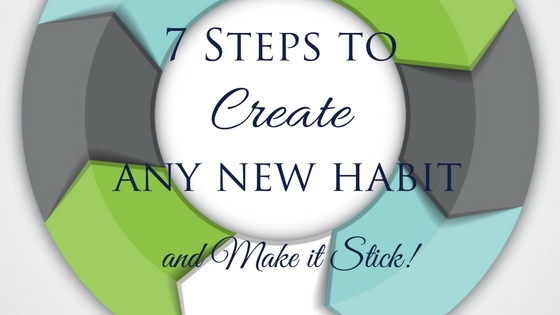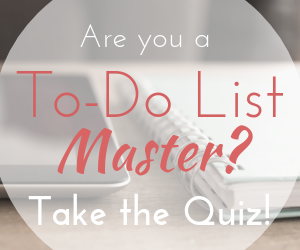We all have habits that we would like to build, shift, or adjust in our lives. I’ve been shifting my morning and evening routines lately to give me more morning time for yoga while still getting me to bed for my preferred 8.5 hours of sleep because I’ve discovered that those are two crucial elements of my ideal lifestyle.
You might want to be writing more, meditating more, or getting to the gym a few times a week. You might want to replace your negative thinking with more positive or empowering questions. You might want to floss your teeth more! (Won’t your dentist be happy!)
Whatever the newest habit might be for you, most of us really struggle with building or breaking habits. In Charles Duhigg’s great book The Power of Habit, he highlights the basic three steps to building a habit: The Cue, The Routine, and the Reward. At its simplest, I know Duhigg’s steps to be right, but I also find that occasionally they’re not quite enough to really help a habit to stick.
Therefore, in the general spirit of the aphorism “Everything should be made as simple as possible, but not simpler” (often attributed to Einstein,) I would like to propose my own 7 steps to create any habit that adds some additional “stickiness” to Duhigg’s basic structure.
Step 1: Get Specific & Realistic
If you want to build a new habit, then you have to start by figuring out specifically what it is that you want to be doing. Charles Duhigg calls it the “routine,” but I think “getting specific” goes beyond that. Yes, you want to know the steps of action needed. You also want to think through any tasks that will make your new habit possible.
Just saying, “I want to exercise more” ain’t good enough. What kind of exercise might you enjoy doing? Karate? Yoga? Running? Swimming? Biking? Zumba? There are SO MANY options! If you want, you can come up with a menu of options and pick from it to plan you exercise each week.
I’ve become a big fan of both Daily Burn and Gaia’s My Yoga apps which give me a selection of exercise videos with just a few taps on my iPad. In order to work those exercises into you life, what specifically will you need to do in advance?
For instance, choose a location to workout in, download the app(s) onto your device & setup your accounts, make sure you have any gear needed (yoga mat, weights, kettle bells, etc.), choose appropriate workout clothes/shoes, etc. If you want to bike more, then you might want to get your bike serviced. If you want to do martial arts, then you might want to research dojos. These are all the tasks that might be needed before you’re even able to start implementing your habit. In other words, these are the prep steps to make the habit possible. So, add these tasks to your master list, and figure out how to make them a priority.
Then, there are the routine steps of the actual habit: Change into workout clothes, grab any workout gear, make sure that your device has power, etc. You’ll want to make these steps as easy as possible. Most of us will look for any excuse to not do a new habit, so plan ahead to remove as much resistance as possible.
Obviously, exercise is just one example, you could apply the same questioning to anything… like flossing your teeth. Do you have floss in the house? Do you want to try a different kind? Is it some place easy to reach at the appropriate times?
When you get specific like this and think through both the tasks needed to make your habit possible and the prep steps for each new instance of your habit, then you can strategically remove many of the barriers that we use to excuse ourselves from doing our new habit.
You will also want to add a dose of realism to your habit building… in other words. If you’ve been a couch potato for the past 5 years, then exercising for an hour 7 days a week might be a stretch. Set yourself up for success in terms of your expectations. What if you start with 3x week for this season (the next 90 days), then re-evaluate?
Step 2: Why Does It Matter?
Often, we start thinking through these specifics and can get wrapped up in the details. So, step two encourage you to pause for a moment and get really clear about why it matters to you to make this change. We are not programmed to embrace change. In fact, we are biologically designed to maintain the status quo as much as possible because it’s safe (and we won’t get eaten by a tiger on our couch.)
So, if you want to make a change in your life, then you’ll have to have a clear and strong WHY. What will installing this habit mean for you, provide for you, make possible for you? Ideally, frame your why as a positive “moving towards” outcome rather than a negative, fearful “moving away from” outcome.This one shift might help you avoid the rollercoaster results that are common with many behavior changes.
Ideally, post a reminder of this WHY somewhere you’ll see or encounter it while doing the habit. An image of being healthy on the wall, a post-it note on the mirror with your why written on it, an audio recording of you passionately saying your why that you can listen to anytime your mind is creating excuses to skip the habit (just this once.)
If your WHY is strong enough, then it can help you find the motivation to stick to the habit even when your energy is saying… “but I don’t want to get off the couch” [imagine a 3-year old’s whiny voice here.] How can you be a loving parent to your tired, whiny inner child and help him/her recognize that doing your habit is important and good?
Step 3: Where Does It Fit?
As Duhigg explains in The Power of Habit, our brains need to recognize the cue that now is the time to start this specific habit. Which means that before starting our new habit, we’ll want to do some thinking about where it would best fit into our existing pattern and rhythms. Are you going to exercise first thing when you get up? Will it be your mid-day break before lunch? What about right at the end of the work day before dinner? What would work best for you?
If you’re not sure about the answer, then pick one and test it out for 2-3 weeks. Just because you make a choice to exercise in the afternoon now doesn’t mean you can’t change your mind and switch it to the morning later. But, whichever time you choose… this is important… what will happen just before your new habit that will cue you that it’s time?
Without getting really clear about what this cue is you’ll always find yourself missing the opportunity to do your habit. Your brain won’t recognize that now is the time for that pattern and will just stick with what it knows. So, think about it, is it something you’ll see? Hear? Feel in your body? What specifically will happen just before you know that it’s time to start your new habit? My feet will hit the floor to get out of bed; my phone will buzz with my reminder; I will have just finished walked out of my office for the end of the day. Those are all good examples of cues that let your brain know that now is time for your new habit to begin.
Recognize that you might need to test out different times and cues as you begin working on your habit. After all, if you start with a plan of working out first thing and your initial cue is your feet hitting the floor, then you want to move to exercising before lunch, you’ll have to pause and identify the new cue.
Step 4: What’s The Reward?
We have to feel like the effort is worth it to us, which is why our brains look for a reward to motivate our actions. Obviously, know our why and feeling that internal “YES” that we’re working toward something that matters to us can be a great intrinsic reward.
However, rewards come in many varieties. Maybe the social pat on the back that you get when you post on Facebook after your workout is your reward. Maybe each day that you complete your 30 minutes of exercise you get one chocolate kiss afterwards. I have a reward of avocado maki sushi which I enjoy in my car while listening to a podcast or audio book for 10 minutes each week after finishing the grocery shopping. (I really enjoy going to the grocery store now.) Maybe your reward is 5-10 minutes in the steam room at the gym when you’re done.
It’s all about what makes you feel good, and if you can link something pleasurable and joyful to this new habit, then it’s going to make it dramatically easier to consistently execute.
Step 5: Visualize It
OK, the first four steps are all the planning and thinking (and maybe a little doing) that will set your new habit up for success. Now, before you dive into action to implement your new habit. Use the power of your creative mind to visualize the whole process.
Begin by seeing yourself up on a movie screen before the cue for your habit. Then, see yourself recognize the cue and start the new routine. Finally, see yourself enjoying your reward, and then moving on to the next activity in your day.
After watching the whole process (cue, routine, & reward) on the movie screen, then step into the image, fully associated and visualize it again as if it were happening right now. Watch, hear, and feel the process from before the cue, recognizing the cue, imaging how clear and motivated you will feel, and moving through the routine. Then, feel the joy in your success and your reward before you move on to the next part of your day.
It’s very important to start the visualization from before the cue and end it after your reward when you start moving on. Because then you are practicing not just the routine (the core habit itself) but the activities that will initiate and end it allowing you to transition into it and out of it each time.
Step 6: Track It
To invert the classic Peter Drucker quote … What can be measured, can be managed. In other words, if you want to ensure success with your new habit, then track it.
I’ve already written about some of my favorite habit tracking tools. So, pick one and use it to hold yourself accountable for installing your new habit. After all, what makes a habit different is that it happens repeatedly. We have to be able to measure our effectiveness at enacting it over time if we want to ensure that it truly sinks into a comfortable place in our lifestyle.
There may eventually come a point when you don’t need to track it any more because it’s well-established. After all, most of us have no problem showering and brushing our teeth without a tracking reminder, but in the early stages of building the habit we often benefit from some gentle, measured accountability. Kinda like a kid with a chore chart. Heck, you could even create such a habit chart for yourself and give yourself a sticker each time you floss your teeth. Whatever it takes! … and whatever works best for you.
Step 7: Refine It
Some habits are life-long, and others have seasons. Maybe tennis is your sport in the spring and fall, but you prefer to swim in the summer, and cross-country ski in the winter. So, your habits may shift with the seasons.
Or, perhaps a trip with a friend introduces you to Qi Gong, and you decide to start doing that practice in the morning instead of yoga for a while. That’s great! You’re exploring, evolving, and discovering new parts of our world and yourself.
Just because a habit was perfect for you at one point doesn’t mean that it will always be what you want to do. So, give yourself permission to re-evaluate your habits regularly. It can be great to do this with the seasons as part of your seasonal retreat or reflection time. Even better, work on developing your habits one at a time. Give yourself complete focus and dedication to developing each of them with care until then become easy and automatic. Then, next season you can choose a new one.
Maybe you take your seasonal reflection times to shift and tweak things, or uninstall some behaviors and replacing them with others. This shifting and crafting of your life is what allows you to know that you’re living fully and with intention. Soak it in and make it fun!
Next Actions:
What new habit have you been intending to create in your life? Pick one right now and start walking through these seven steps.
If you want to make these steps even easier, then you can download your Habit Creation Growth Sheets & Habit Tracking Worksheet by clicking the button below.
Images for Blog Post: Image used under License Agreement: ©Theseamuss / Stockfresh



